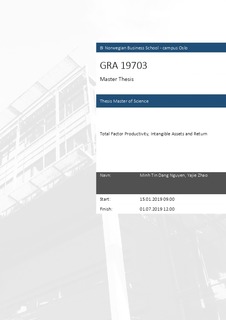Total Factor Productivity, Intangible Assets and Return
Master thesis

Permanent lenke
http://hdl.handle.net/11250/2623814Utgivelsesdato
2019Metadata
Vis full innførselSamlinger
- Master of Science [1621]
Sammendrag
Empirical evidences documented many links between firm characteristics with
stock returns. Even with the Fama-French three factor model in 1992, there are still
a lot of abnormal returns cannot be explained by CAPM model or Fama-French
model (Fama and French, 2009). While when researchers are focusing on specific
financial proxies to explain the return, there are other researches that developed
intuitively from the macro-economic, and in theory with appropriate proxy and
estimation method, the empirical evidence can be found the micro-economic level.
The Investment CAPM is one of these theories, instead of using the equilibrium
condition from the relationship between supply and demand, it pursues the asset
pricing from a different perspective than the behavioural finance.
Total Factor Productivity (TFP), on the other hand, is developed from macroeconomic
level for explain the growth of the country’s GDP and defined as “the
portion of output not explained by the amount of inputs used in production” (Diego
Comin, 2006). Unlike the Investment CAPM, productivity is the key source for
economic growth and productivity growth is the key economic indicator of
innovation.
Economic growth can take place without innovation through replication of the
established technologies (Jorgenson, 2009). While there are empirical evident about
the link between the firm-level TFP and the stock returns, the traditional firm-level
TFP focuses on the physical capital and labour. However, firms are investing big
amounts into intangible assets such as R&D, software, brands …etc “at a rate close
to that of tangible assets” (Ellen R. McGrattan, 2017). Therefore, in this study, we
incorporate the intangible capital and the investment in intangible capital into the
firm-level TFP measurement.
This paper provides the evidences about the link between this new firm-level TFP
with intangible capital and stock return. Chapter 2 is the literature review for the
development of the TFP theory and the relevant estimation methods. Chapter 3 is the data collection and estimation method. Chapter 4 is the data analysis and the
robustness check. Chapter 5 is the conclusion.
Beskrivelse
Masteroppgave(MSc) in Master of Science in Finance - Handelshøyskolen BI, 2019